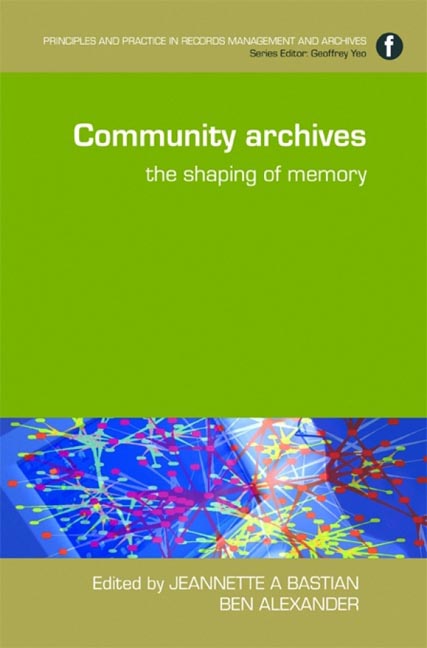Book contents
- Frontmatter
- Contents
- Introduction to the series
- Acknowledgements
- Contributors
- Introduction: Communities and archives – a symbiotic relationship
- Part 1 A community archives model
- Part 2 Communities and non-traditional record keeping
- Part 3 Records loss, destruction and recovery
- Part 4 Online communities: how technology brings communities and their records together
- Part 5 Building a community archive
- Conclusion: The archivist and community
- Bibliography
- Index
- Miscellaneous Endmatter
- Miscellaneous Endmatter
- Miscellaneous Endmatter
Conclusion: The archivist and community
Published online by Cambridge University Press: 08 June 2018
- Frontmatter
- Contents
- Introduction to the series
- Acknowledgements
- Contributors
- Introduction: Communities and archives – a symbiotic relationship
- Part 1 A community archives model
- Part 2 Communities and non-traditional record keeping
- Part 3 Records loss, destruction and recovery
- Part 4 Online communities: how technology brings communities and their records together
- Part 5 Building a community archive
- Conclusion: The archivist and community
- Bibliography
- Index
- Miscellaneous Endmatter
- Miscellaneous Endmatter
- Miscellaneous Endmatter
Summary
Introduction: feeling good
Invoking the notion of community as part of our professional mandate is another way we can feel good about what we do. We feel good if we can say we build or connect to community, even if we are not altogether sure about what it means. Indeed, community may have as many definitions as information. Social pundits invoke it to urge citizens to take control of improving the quality of their lives and to understand a broader public good. Real estate agents carefully describe it to market and sell a house, affirming that location is everything. Historians study its meaning, or use it as a means of focusing their investigations. Sociologists use it as a way of investigating social, political, economic and other trends in society. Journalists and others in the media use the term for their investigative reporting.
Community is seen by many to be an asset; to not belong to a community is a problem, a detriment to living out life to its fullest. The point here is that being part of some sort of community is deemed to be a normal part of humanity, and it is seen as an essential objective if one seems disconnected from a community. Professions, such as are represented by archivy, are also communities, and archivists usually feel just as good when they commune with each other at conferences, workshops and other venues.
The current interest in community may be the result of so many thinking it is endangered in the digital era. Before a few hundred years ago, humanity lived in local communities, and they often could do so in some degree of isolation. The rise of commercial networks, the broadening intellectual Enlightenment, the emergence of telecommunications, the demands of the Industrial Revolution for raw materials, and the electronic computer revolution all brought with them threats to how we conceived community. Another way of looking at this is to understand the shift from agrarian to mechanical to virtual time, where we see a transition from very natural to extremely artificial notions of timing our daily routines. The earliest notions of community were delineated by how far one could walk to beat out a living and back again, and that distance kept expanding from feet to horse or animal power to steam, then automotive and, finally, air power.
- Type
- Chapter
- Information
- Community ArchivesThe shaping of memory, pp. 251 - 264Publisher: FacetPrint publication year: 2009



